Animals unusual
Fennec, the big eared fox
 It
is the smallest and palest of the foxes and strongly resembles a little
dog. In fact, some suggest that the popular breed of dog known as the
Chihuahua was originally a domesticated Fennec, and not a breed of dog
as such. Anyway, due to the animal's harmless nature, the Fennec has
become the only species of fox that can be kept properly as a pet.
However, it is difficult to completely domesticate it. It
is the smallest and palest of the foxes and strongly resembles a little
dog. In fact, some suggest that the popular breed of dog known as the
Chihuahua was originally a domesticated Fennec, and not a breed of dog
as such. Anyway, due to the animal's harmless nature, the Fennec has
become the only species of fox that can be kept properly as a pet.
However, it is difficult to completely domesticate it.
This small fox found in the Sahara desert of North Africa and some
parts of Arabia, belongs to the canid family.
It is the smallest among foxes with a body length of up to 16 inches
(36-40 cm), a tail measuring 8-12 inches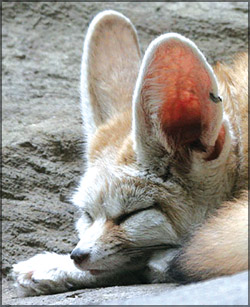 (20-30 cm) and a weight of around 1.5 kg (3.3 lb). Like many desert
(20-30 cm) and a weight of around 1.5 kg (3.3 lb). Like many desert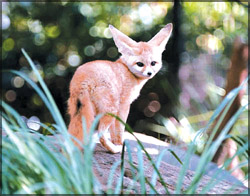 species, it lives in burrows in the sand. It can dig very rapidly, up to
20 feet in one night, in its natural environment. Even though it is
small, it is unusually agile. It can spring up to 70 cm (28 in)
vertically and about 120 cm (four feet) horizontally from a standing
point.
species, it lives in burrows in the sand. It can dig very rapidly, up to
20 feet in one night, in its natural environment. Even though it is
small, it is unusually agile. It can spring up to 70 cm (28 in)
vertically and about 120 cm (four feet) horizontally from a standing
point.
It is a nocturnal creature and is omnivorous. It hunts for rodents,
insects such as locusts, lizards and birds at night. It also eats birds'
eggs and fruit (berries).
What is distinctive about the Fennec is its huge ears ... Remember
the big ears grandma wolf had in Red Riding Hood and what she had to say
about them when Red Riding Hood asked "why they are so big?" "All the
better to hear you with", was the wolf's reply.
The Fennec's ears are much bigger than the wolf's. In fact, they are
about 5.9 inches long (15 cm) and the largest of any carnivore relative
to its size. Because of its huge ears, the Fennec can hear another
animal moving up to 1.5 km (one mile) away. Now, isn't that amazing?
This small, rather cute-looking fox has sandy coloured fur to blend
with the desert environment it usually lives in. The coat can repel
sunlight during the day and conserve heat at night. Its soles too are
covered with fur to protect them from the hot sand.
It normally gets most of its water requirement from the food it eats,
but drinks water when available. It can however survive for long periods
of time without water.
These furry little mammals live in groups of up to 10 animals. The
females litter 2-5 young in the spring (March-April) and nurse them
(give them milk) for about a month.
They live for about 10-12 years.
****
Least Weasel - the smallest living
carnivore
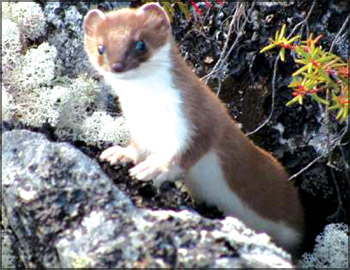 Seldom
seen even in its natural habitat of woodlands, meadows, farmlands and
brushy areas, the Least Weasel is the tiniest in the weasel family.
However, it is widely distributed throughout the northern hemisphere
except Ireland and Iceland. Seldom
seen even in its natural habitat of woodlands, meadows, farmlands and
brushy areas, the Least Weasel is the tiniest in the weasel family.
However, it is widely distributed throughout the northern hemisphere
except Ireland and Iceland.
It has a slender body with a long tail and short legs. The fur is
reddish ginger in colour and brighter than that of most weasels. Its
belly fur is white.
Like all weasels, it undergoes a colour change in winter. Its coat
becomes white to blend with the snowy background and is popularly
referred to as the 'snow mouse' in Norway and Sweden. Its winter coat,
though white like that of other weasels, turns a bright lavendar colour
under ultraviolet light unlike that of other weasels.
The Least Weasel is about 158-184 cm (6.3-7.4 in) in length and
weighs around 35-70 g (1.3-3.6 oz). It can
|
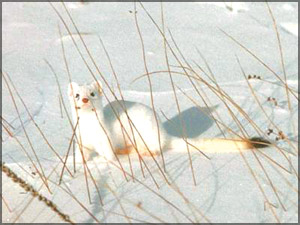
In its white winter fur coat
|
run fast even though its small in size. It can even climb and
swim quite well when necessary, especially when chasing prey such as
small shrews, moles and birds. Its diet also includes nestlings and
eggs. Did you know that this small creature consumes 40 per cent of its
own weight in food?
The Least Weasel has several dens. It often uses abandoned burrows or
dens of mice, which they build with the hosts' own fur to keep its
babies warm in the winter. The female has 3-10 young per litter with up
to three litters per year.
***
Star-nosed mole
|
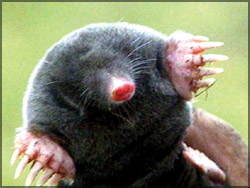
In other moles the tentacles are not so prominent
|
If you look at the
picture, you are bound to wonder if this bizzare looking creature is
real. Well, it is. This small, North American mole is found in eastern
Canada and north eastern U.S.A.
Found mostly in wet lowland areas, the star-nosed mole survives on
small invertebrates, aquatic insects, worms, and molluscs. It is a good
swimmer and is active both day and night. Even in winter it is active.
Even though very little is known about its social behaviour, it is
believed that the star-nosed mole lives in colonies.
Now, let's look at its physical features that makes it bizzare. The
22 mobile, pink coloured and fleshy tentacles at the end of its snout
are its distinctive features. These nasal tentacles are incredibly
sensitive and are covered with almost one hundred thousand
|
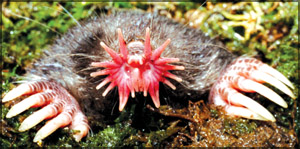
The snout of the star-nosed mole
|
minute touch receptors, known as Eimer's organs.
They are named after the German zoologist, Theodor Eimer who first
discovered them in moles in 1871. All moles have these tentacles as they
are functionally blind and rely on touch to even identify food. But
these tentacles are not as specialised or numerous as those of the
Star-nosed mole.
These tentacles are used to identify food.
|
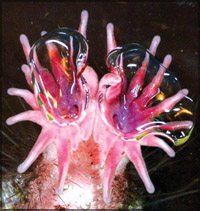
Breathing air bubbles
through its nose
|
The body of the star-nosed mole is covered in thick, blackish brown,
water repellent fur. It has large scaled feet, paddle-shaped hands and a
compact body. The tail is thick and long. It has 44 teeth! A dozen more
than humans. A star-nosed mole is about 15-20 cm in length and weighs 55
grams.
It's a very powerful creature in relation to its size. It uses its
paddle-shaped hands and compact body (in a twisted motion), to construct
a network of tunnels, half a metre below the surface, but above the
water table. It usually makes nests out of dried grasses and other
vegetation.
****
Numbat, the dwarf anteater
Some of you may be
familiar with the appearance of an anteater and must be wondering how
the Numbat is classified as an anteater.
It certainly looks so different to the usual long snouted anteaters
you may have seen in pictures. In fact, the Numbat is often referred to
as the 'Giant Australian Chipmunk' because it looks more like a squirrel
than an anteater. But, it is an anteater and the only marsupial in the
world that feeds exclusively on ants and termites.
The Numbat is one of the only two species in the Myrmecobiidae family
and is considered highly endangered.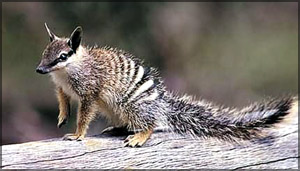 Although it once lived throughout much of southern Australia, the Numbat
is today restricted to the southwestern corner of Western Australia.
Although it once lived throughout much of southern Australia, the Numbat
is today restricted to the southwestern corner of Western Australia.
Even though the Numbat or the Banded Anteater, as it is also known,
and its sister species, the Rusty Numbat, exhibit many features
characteristic of other anteaters, these two species are rather small in
size.
In fact, the Numbat is only 245 mm (9.8 in) in length with a tail of
180 mm (7.2 in). The male weighs around 495 g (17.5 oz) while the female
is around 415 g (14.5 oz). It is a marsupial, but is considered a
curiosity among them due to its different physical features.
For example, the Numbat is the only diurnal marsupial, being active
only during daylight. It also has the largest brain for its body size of
any living marsupial. Another unusual feature is the number of teeth it
has. Compared to other marsupials, it has the largest amount, numbering
50 in all, though they are somewhat primitive and are never used for
biting.
What makes the Numbat unique among marsupials is the lack of a pouch.
You must be aware that generally, marsupials like the kangaroo carry
their young in a pouch. But, the Numbat's young cling to the female's
nipples instead. The female litters about 3-4 baby Numbats.
The rat-sized Numbat is strikingly coloured, with a reddish brown
back marked with white bands. Like all anteaters, the Numbat also has a
long snout, a bony palate on which to crush termites, strong claws for
digging of ants and a long cylindrical tongue. |
